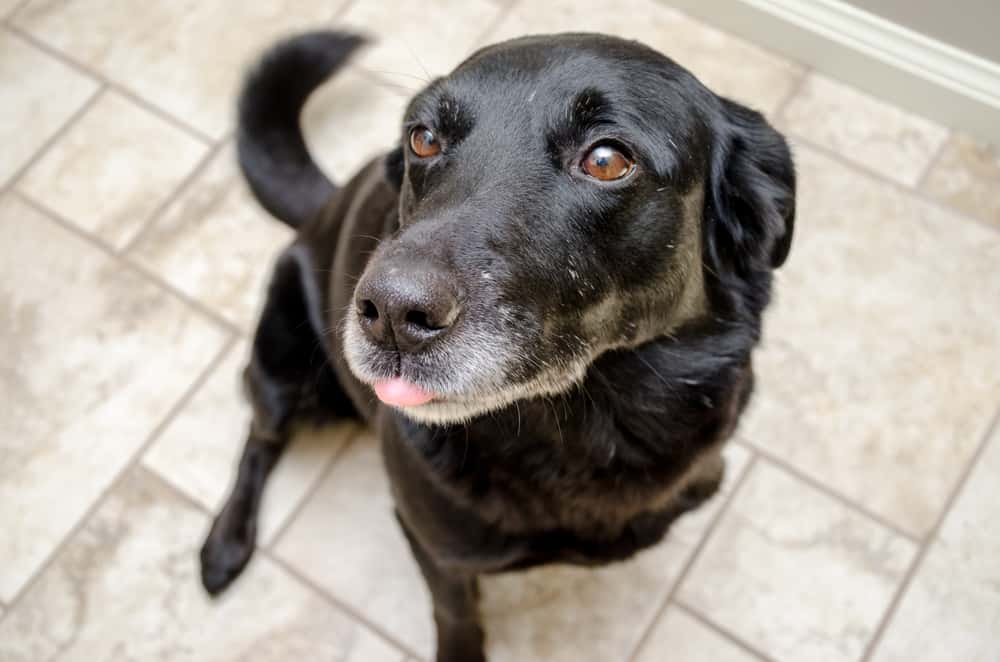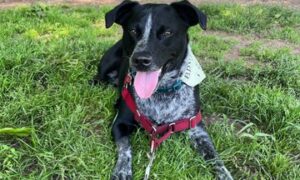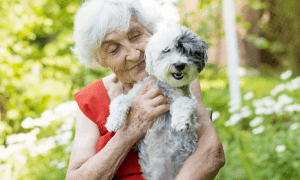“This post contains affiliate links, and I will be compensated if you make a purchase after clicking on my links.”
Pets make excellent companions, especially during the retirement years. And, when you own a pet, it is important to be aware of happy tail syndrome. The happy tail syndrome may not mean what you think it does.
Happy tail syndrome is when a dog injures its tail by wagging it forcefully at an object. These injuries can result in blood spatters across walls and even ceilings. It is more common in large dogs due to their size and the force they can generate when excited. It is also seen more often in short-haired dogs because they lack the padding a fluff of fur provides. Some dogs wag their tails so forcefully, their backend lifts off the ground, like propellers on a helicopter.

What causes a happy tail?
A dog’s tail has as few as five and as many as 20 bone segments along the tail that make up the caudal vertebrae. In some breeds, the skin covering the tail is thin. When it also has short hair, shorter than its body hair, it is more easily injured. The tail also contains many blood vessels. These factors combined with the dog’s size and the force with which it can show delight make the tail susceptible to injury, especially when it comes into contact with sharp-edged surfaces such as wall corners or table edges.
Not all tail wagging results in injury, but when it does, simple first aid can provide pain relief and protection from future harm.
What to do about the too-happy tail
Assess the damage and protect the tail
First, assess the damage. Some injuries can be bad enough to warrant an emergency vet visit, but with only 2% of Americans having pet insurance, it can be an expensive trip. If you cannot for whatever reason see a vet, wrapping the tail bolsters the healing process. For someone not comfortable wrapping the tail, this is a good reason to visit the vet. These injuries often lead to blood loss, so those performing first aid measures need to be confident they will not become upset by looking at the wound.
Preparation for tail wrapping
Simple first aid skills will promote the healing process, provide protection while it heals, and protect surfaces from further stains. To wrap the tail, gather:
- Antibiotic ointment
- Roll of first aid gauze
- Non-stick gauze pad
- Wad of cotton
- First aid tape (about 1-inch wide)
- Scissors
Pre-cut and set aside tape strips so they are ready when needed. Typically two long pieces (about eight inches long), and six pieces about four inches long are required. Another four-inch piece cut in half along the four-inch length is used to hold the gauze pad in place.
Before beginning, clean the tail thoroughly, not just the injured area. Use warm, soapy water and rinse until all suds are gone.
Step 1: Apply the ointment to the gauze or cotton pad—it’s usually more manageable than trying to apply the ointment directly to the injury.
Step 2: Place the gauze pad over the injury and use the two narrow strips of tape to wrap around the tail in a spiral format to hold the pad in place. Don’t wrap too tightly but do ensure there is enough pressure to keep it in place while covering.
Step 3: Unroll enough gauze to go down the entire length of the tail one and a half times.
Step 4: Start at the top, near where the tail meets the body. Wrap the gauze strip around the tail twice to create an anchor.
Step 5: Wrap a strip of tape around the dog’s tail to hold this in place.
Step 6: Continue wrapping the gauze strip in a spiral pattern around the tail, overlapping each row by about a quarter of the strip width.
Step 7: At the injured area, secure the strip with the tape going around the tail.
Step 8: Place the cotton wad over the gauze pad and continue wrapping the length around the tail to hold this in place.
Step 9: Just after the wound, place another piece of tape around the tail.
Step 10: Finish wrapping down to the tip but do not cover the tip. The wrap should be firm, but not tight to ensure contact between the ointment and the skin’s surface.
Step 11: At the end of the tail, wrap a piece of tape around the tail, making sure the tape is in contact with the hair.
Step 12: Add a piece of tape above this, overlapping the first piece of tape by half the tape’s width.
Step 13: Change this dressing as needed, but no less than daily.
Visit the vet
Make an appointment to see your veterinarian or search for a vet online if you’re in lockdown. It’s possible there are broken bones, and these may require treatment. The wound may also require stitches if the vet doesn’t think it will heal on its own.
If a dog’s happy tail results in repeated injuries, your vet may recommend other options. It helps to keep the dog calm and remove or pad harmful edges. Another way is to provide more space for the dog in areas of the house where injuries happen.
Removing the bandage
It can take up to two weeks for the tail to heal, depending upon the severity of the wound. Removing the tape stuck might be painful, so trying soaking the area with vegetable or olive oil first. Alternatively, bathe the dog and let the water and suds loosen the adhesive. If it’s just a few strands of hair, use scissors to cut it away.
Wrapping it up
Dogs with happy tails can cause injury to their tails requiring immediate medical assistance or at least a protective wrapping. Using everyday first aid items, dog owners provide interim medical treatment and protection while the wound heals.
To minimize the chance of injury, consider the areas where the dog is most excited, such as the foyer when heading out for a walk. Remove sharp-edged furnishings or fixtures or pad edges with edge and corner protectors available at the hardware store.
Happy dogs have happy tails, but when happy becomes harmful, wrapping the dog’s talk can be the best line of defense. Check out this article dog obedience training tips, if you want to learn more about tips to take care of your dog.
About the Author:
Emma is a professional writer and blogger, with two furry friends and a lot of pet behavioral and pet health knowledge to share. She has written for numerous big animal magazines and health sites, and is a regular contributor to The Catington Post.


















